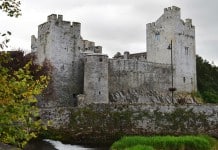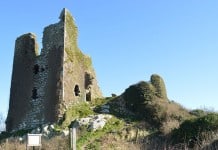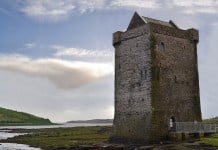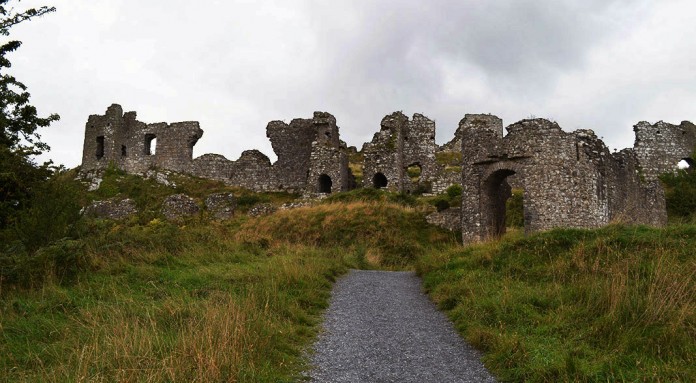
For lovers of Irish history and tourists visiting the area, the Rock of Dunamase, or Dún Másc, is a must-see, and is one of County Laois’ greatest treasures.
Castle history
Historians believe that use of this site could date back as far as 2,000 years, with earlier occupiers of the Rock of Dunamase including Phoenician sailors and traders in the second century. The evidence for this comes from a map of Ireland in the second century that was drawn by Ptolemy, the Greek cartographer. It flags up a local site marked ‘Dunum’, which could be Dún Másc, or Dunamase, although this is speculation since no archaeological evidence exists to substantiate the suggestion. Castle fortifications have been in place since at least the ninth century, but the existing ruins were constructed late in the twelfth century as a stronghold of the McMurrogh clan. Ownership later passed to Strongbow, and then on to William Marshall’s family, where it stayed until it fell into disrepair in the fourteenth century. This was largely due to under-occupation. Eventually, the now ruined castle was blown up in around 1350, and rendered entirely unusable by Cromwell and his armies.
The castle’s name means ‘fort of Másc”‘. This refers to an early Christian leader, and certainly the rock’s summit was once topped with a wooden Celtic structure. The stone castle was built in 1250 by the King of Leinster, Dermott Mac Murrough who is believed to have invited the Normans to the country. Aoife, his daughter, married Richard De Clare, who led the Normans. The castle passed to his family as part of her dowry and he invested heavily in it in order to build a powerful fortification, parts of which you can still see today. Later on, it passed onto William Marshall, the Earl of Pembroke, and then to Roger Mortimer. After this it became the property of the O’Moores, who were at the time, Laois’ most powerful local family. They ruled for two further centuries.
The castle was later passed back into Irish hands during the Gaelic resurgence. After it became abandoned in 1350, the army blew it up to prevent it from falling into enemy hands and being used again. By the eighteenth century, Sir John Parnell did some restoration work with a view to transforming the site into an ornate banqueting hall. His efforts led to the preserved building you see today, since he stopped the walls from collapsing and even re-built those which had already fallen in places. However, despite his work, his son allowed it to fall back into decay.
The castle is a national monument and would have been a large and complex development in its prime. It is known for being one of the most impressive of Ireland’s historical sites, largely due to its placement on a limestone crop that rises above the local plains. This explains its original choice of location as a defensive structure and vantage point for establishing control.
Upon approach
The castle stands at an impressive 150 feet above ground, which is slightly less than Cashell. The surrounding area is increasingly well cared for, thanks to restoration funds granted to the country’s national heritage funds as part of the ‘Celtic Tiger’ programme. Previously, particularly back in the 1980s, the site was heavily overgrown with gorse and was relatively difficult to access. Although parking was available outside the site, the only way to access it was via a challenging and rocky climb. A successful ascent merely resulted in scrabbling around in undergrowth that was becoming out of control in, on and around the ruins.
However, things have now changed dramatically after the OPW restored the site in 2006 and made it suitable for public visits. Some major excavations were undertaken as part of this, and there is now excellent accessibility. Parking is available outside and is free. From the car park, you will find paved walkways and wooden steps which lead directly up to the castle.
The ruin has a gate and lower Barbican, together with a lower ward, curtain wall and upper ward. You will also see what remains of the original great hall. You can turn left or right when you pass through the Barbican gate, and both offer you the option of fully circumnavigating the castle. The gatehouses are the best preserved sections, together with the surrounding triangular courtyard.
Your visit
You will usually find that you have the castle to yourself because it is largely off the beaten track and not widely known. If you have time, it is well worth visiting nearby Holy Trinity Church which can be seen from the castle. This has a number of interesting features, including old churchyard stones. If you find that the gate to the Churchyard is locked, you can access it by the surrounding wall which has a permanent stone stile.
Local features
You will find that the views from the former Strongbow and Cromwell hold of the Rock of Dunamase are absolutely beautiful. In addition to the lovely Holy Trinity Church which sits just below Dún Másc, you will be presented with vast, rolling meadows that stretch out as far as the eye can see. On a clear day you will find that you can observe the local landscape for miles. Look out for Wicklow’s Great Sugarloaf and the famous Slieve Bloom mountain range.
Accessibility
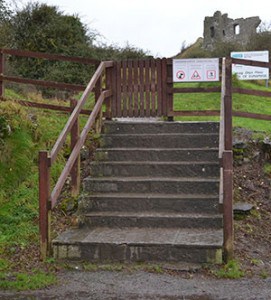
The wooden steps and gravel paths to the Rock of Dunamase make it easy to reach from the nearby car park. Be careful when circumnavigating the Strongbow Dún Másc castle however, as there is a very deep gully to its rear. Stick to the path and keep a careful eye on any children. You will see that there is still a fair amount of debris present in the upper ward from Cromwell’s destruction, however this is safe to touch and to move around. Wheelchair users, provided they can manage to negotiate the entrance steps to the site, will find that they can travel up to the castle and explore the outer area. To travel to the Rock of Dunamase, the easiest route is to exit at Junction 16 of the M7 from Dublin. After the exit, you will approach a mini roundabout. From here, take the second exit onto Old Road and drive on until you see the castle ruins on your right. Access to the car park is on the right. It is around five miles from Portlaoise, which is also worth a visit if you are exploring the local area.

